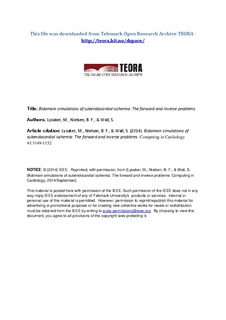Bidomain Simulations of Subendocardial Ischemia: The Forward and Inverse Problems
Journal article, Peer reviewed
Published version
Permanent lenke
http://hdl.handle.net/11250/2438581Utgivelsesdato
2014-09Metadata
Vis full innførselSamlinger
Originalversjon
Lysaker, M., Nielsen, B. F., & Wall, S. Bidomain simulations of subendocardial ischemia: The forward and inverse problems. Computing in Cardiology 2014; 41: 1149-1152Sammendrag
We provide an analysis of the bidomain theory in relation to anterior subendocardial ischemia. Using the static bidomain model, this analysis explains why simulations often do not produce ST depression when the ischemia is introduced into an anisotropic model. More precisely, if the ischemic border zone is represented as a smooth surface, then almost right angles between the normal vector of the border and the tangential plane of the fibers will lead to cancelling effects. The simulated transmembrane current flux, entering the ischemic region, will thus be underestimated, and the expected ST depression in chest leads may not occur. We propose to solve this problem by either representing the ischemic border zone as a zigzag surface or by specifying the transmembrane current flux along the border zone, instead of the shift in the transmembrane potential. We employ the latter approach and show that this method always yields ST depression in chest leads positioned above the lesion. A number of simulation studies will be presented, including clinical cases. Both the forward and the inverse problems of electrocardiography are addressed. We consider the inverse ECG problem in which ischemic heart disease is assumed to be the source of changes in the body surface potential maps (BSPMs).
